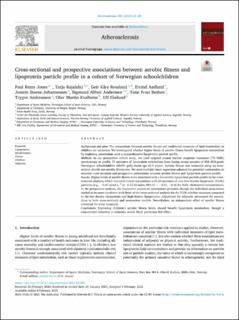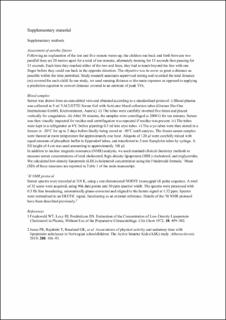| dc.contributor.author | Jones, Paul Remy | |
| dc.contributor.author | Rajalahti, Tarja | |
| dc.contributor.author | Resaland, Geir Kåre | |
| dc.contributor.author | Aadland, Eivind | |
| dc.contributor.author | Steene-Johannessen, Jostein | |
| dc.contributor.author | Anderssen, Sigmund Alfred | |
| dc.contributor.author | Bathen, Tone Frost | |
| dc.contributor.author | Andreassen, Trygve | |
| dc.contributor.author | Kvalheim, Olav Martin | |
| dc.contributor.author | Ekelund, Ulf | |
| dc.date.accessioned | 2021-11-08T12:11:57Z | |
| dc.date.available | 2021-11-08T12:11:57Z | |
| dc.date.created | 2021-02-18T17:06:10Z | |
| dc.date.issued | 2021 | |
| dc.identifier.citation | Atherosclerosis. 2021, 321, 21-29. | en_US |
| dc.identifier.issn | 0021-9150 | |
| dc.identifier.uri | https://hdl.handle.net/11250/2828366 | |
| dc.description | This article is an open access article distributed under the terms and conditions of the Creative Commons Attribution (CC BY) license (https://creativecommons.org/licenses/by/4.0/). | en_US |
| dc.description.abstract | Background and aims: The associations between aerobic fitness and traditional measures of lipid metabolism in children are uncertain. We investigated whether higher levels of aerobic fitness benefit lipoprotein metabolism by exploring associations with a comprehensive lipoprotein particle profile.
Methods: In our prospective cohort study, we used targeted proton nuclear magnetic resonance (1H NMR) spectroscopy to profile 57 measures of lipoprotein metabolism from fasting serum samples of 858 fifth-grade Norwegian schoolchildren (49.0% girls; mean age 10.0 years). Aerobic fitness was measured using an intermittent shuttle run aerobic fitness test. We used multiple linear regression adjusted for potential confounders to examine cross-sectional and prospective associations between aerobic fitness and lipoprotein particle profile.
Results: Higher levels of aerobic fitness were associated with a favourable lipoprotein particle profile in the cross-sectional analysis, which included inverse associations with all measures of very low-density lipoprotein (VLDL) particles (e.g., −0.06 mmol·L−1 or –0.23 SD units; 95% CI = −0.31, −0.16 for VLDL cholesterol concentration). In the prospective analysis, the favourable pattern of associations persisted, though the individual associations tended to be more consistent with those of the cross-sectional analysis for the VLDL subclass measures compared to the low-density lipoproteins and high-density lipoproteins. Adjustment for adiposity attenuated the associations in both cross-sectional and prospective models. Nevertheless, an independent effect of aerobic fitness remained for some measures.
Conclusions: Improving children's aerobic fitness levels should benefit lipoprotein metabolism, though a concomitant reduction in adiposity would likely potentiate this effect. | en_US |
| dc.language.iso | eng | en_US |
| dc.subject | adiposity | en_US |
| dc.subject | children | en_US |
| dc.subject | fitness | en_US |
| dc.subject | lipoproteins | en_US |
| dc.subject | metabolomics | en_US |
| dc.title | Cross-sectional and prospective associations between aerobic fitness and lipoprotein particle profile in a cohort of Norwegian schoolchildren | en_US |
| dc.type | Peer reviewed | en_US |
| dc.type | Journal article | en_US |
| dc.description.version | publishedVersion | en_US |
| dc.rights.holder | © 2021 The Author(s) | en_US |
| dc.source.pagenumber | 21-29 | en_US |
| dc.source.volume | 321 | en_US |
| dc.source.journal | Atherosclerosis | en_US |
| dc.identifier.doi | 10.1016/j.atherosclerosis.2021.02.002 | |
| dc.identifier.cristin | 1891508 | |
| dc.description.localcode | Institutt for idrettsmedisinske fag / Department of Sports Medicine | en_US |
| cristin.ispublished | true | |
| cristin.fulltext | original | |
| cristin.qualitycode | 1 | |

